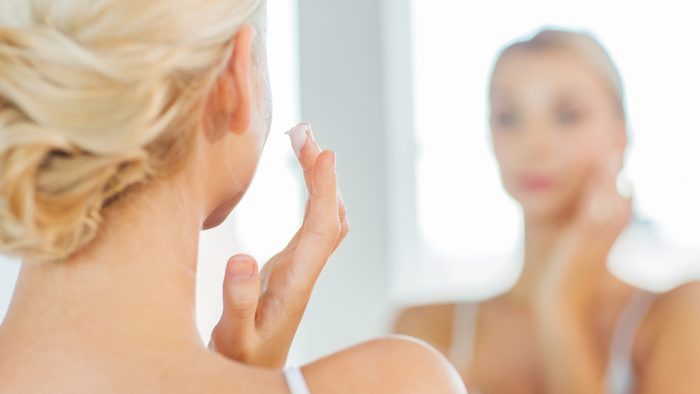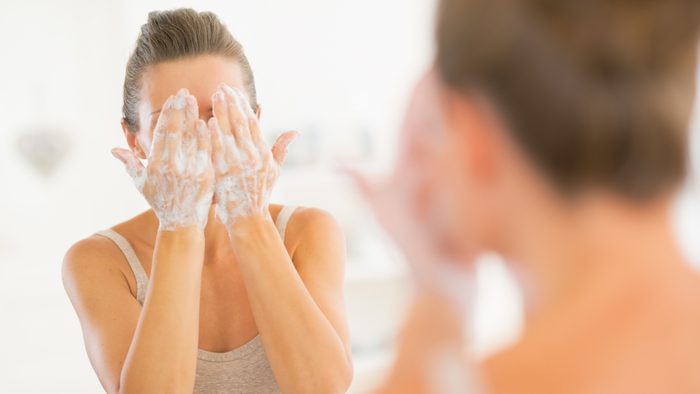
Skin damage from pollution
When you think of pollution and the effect it has on your skin, you might think about dirt and grime that you wash off your face at the end of a long day. But it goes much deeper than that —literally. “Pollution particles are really small; about 400 times smaller than a skin pore,” says Dr. Angela Murphy, a dermatologist and vice president of technology and innovation for Dermalogica. “So imagine how easily they can get into the skin.”
Combine that with other external factors like UV rays, and even stress and diet, and your skin is under daily assault. According to Dr. Murphy, these external factors account for about 50 percent of aging; the rest being up to your genetics. And while you can’t change genetics, you do have some control over these environmental factors.

What is pollution doing to my skin?
Skin damage from pollution is similar to the that of sun exposure. Think loss of radiance, dehydration, deeper wrinkles and other symptoms of premature aging. (Pollution even damages your hair similar to the way UV rays do!) Both UV rays and pollution generate free radicals in the skin, which essentially burrow into the skin and create something called oxidative stress, says Dr. Murphy. “What they’re doing in the skin is damaging proteins, damaging lipids and DNA, and this damage inside the cells accumulates over time,” she says. “It’s that accumulation of damage that leads to fine lines, wrinkles and hyperpigmentation.”
So what can you do to protect yourself? “Well, we can’t all move to the country,” says Dr. Sandy Skotnicki, a dermatologist and founder of Toronto’s Bay Dermatology Centre. (But if you are thinking about moving, you may want to avoid the Canadian cities with the worst air pollution.) “Dermatologists like me have spent the last 20 years talking about how harmful ultraviolet exposure can be for the skin,” Dr. Skotnicki writes in her new book, Beyond Soap. She speculates that airborne pollutants are what dermatologists will spend the next 20 years talking about.
Read on for expert strategies on how to prevent skin damage from pollution.

Use sunscreen
One of the best ways to prevent skin damage from pollution is something you’re already doing everyday. (Right?) “You can protect yourself from pollution and the sun at the same time. That’s why mineral sunscreens are great for day-to-day use,” says Dr. Skotnicki. “I usually recommend a physical product for the face, like titanium or zinc. I use one everyday — it creates a barrier against pollution, it provides a bit of coverage (if it’s a tinted product) and it’s a sunscreen.” (Here are the best mineral sunscreen options you can buy in Canada.)
As experts become more vocal about the effects of airborne pollutants, the beauty industry is answering with new products for protection. Canadian skincare brand Reversa recently launched an anti-pollution multi-protector called Urban Protection Hydrating Care SPF 30 ($47 at drugstores). Formulated with vitamin E and kopara extract to help produce skin barrier lipids, it’s a broad spectrum sunscreen and also protects skin from airborne pollutants. Another homegrown company, Marcelle, recently launched an anti-pollution skincare line, aptly named City. The line consists of a Micellar Foaming Cleanser ($15), High Protection Urban Day Cream SPF 30 ($22), and 24H Antipollution Day & Night Moisturizing Emulsion ($22 at drugstores), with the hero ingredient being kakadu plum extract, which is high in vitamin C.

Vitamin C is the star
When it comes to anti-aging, there are three things with the most science behind them, says Dr. Skotnicki. Those are sunscreen, retinol (which is a key ingredient for a youthful complexion) and stabilized vitamin C, she says.
“Vitamin C is a super powerful defense mechanism,” agrees Dr. Murphy. Vitamin C essentially works to disrupt three major processes that are causing damage and premature aging. It neutralizes free radicals from oxidative stress, inhibits the production of enzymes that degrade collagen, and stops melanogenesis (the process of pigmentation).
The one downside is actually the very thing that makes it a great antioxidant: it’s easily oxidized. “When the vitamin C has oxidized, it’s already used up and it’s no longer effective,” says Dr. Murphy. Watch out for any products that have turned brown and don’t smell very good. That’s a sign the vitamin C has oxidized.
However, thanks to new technologies, Dermalogica has been able to develop an ultra-stable vitamin C complex called BioLumin-C Serum ($118 at dermalogica.ca). The unique complex combines two super stable forms of vitamin C together. There’s also some exciting new research that shows vitamin C not only protects against environmental aggressors, but it can also enhance the skin’s natural defense system. As Dr. Murphy explains: “It’s like coaching the skin to defend itself.”

Exfoliate, but be gentle
Contrary to what you might think, you don’t want to scrub your face at the end of each day. Your skin has a natural barrier and washing too often or scrubbing too hard damages or removes that barrier, says Dr. Skotnicki. But you don’t want to skip exfoliation altogether. Stephen de Heinrich de Omorovicza, founder of Hungarian skincare brand Omorovicza, says this is the biggest mistake people make with their skin. “Dead skin accumulates on the surface and not only does it create a dull and lackluster complexion but it also makes it more difficult for your serums and moisturizers to penetrate the skin and work effectively,” he says.
The key is gentle exfoliation. Dr. Skotnicki says both physical exfoliators (ie. scrubs) and chemical exfoliators (ie. acids) are good options, but she typically recommends a chemical exfoliant. Try Omorovicza Acid Fix ($140 at omorovicza.com), a blend of alpha hydroxy and beta hydraoxy acids like glycolic, salicylic and lactic which exfoliate and also help encourage cell renewal to reverse the effects of sunlight, pollution and acne; or SkinCeuticals Discoloration Defense ($125 at skinceuticals.ca), a newly launched corrective serum that targets hyperpigmentation with tranexamic acid.
Regular facials will also help keep your skin in top shape. Visit a facialist at least once every few months when the seasons change to update your skincare routine for the change in weather.
Curious about collagen supplements? Here’s the truth on what collagen can do for your hair and skin.
